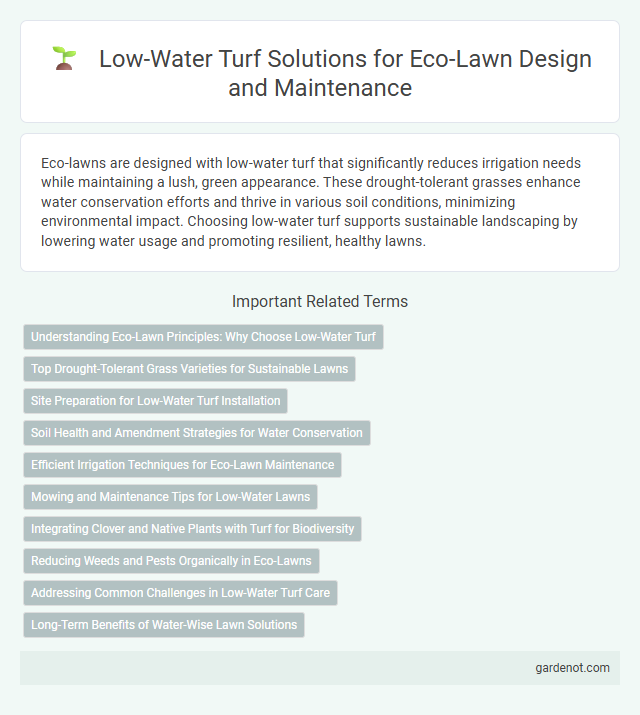Eco-lawns are designed with low-water turf that significantly reduces irrigation needs while maintaining a lush, green appearance. These drought-tolerant grasses enhance water conservation efforts and thrive in various soil conditions, minimizing environmental impact. Choosing low-water turf supports sustainable landscaping by lowering water usage and promoting resilient, healthy lawns.
Understanding Eco-Lawn Principles: Why Choose Low-Water Turf
Low-water turf in eco-lawn design reduces water consumption by up to 50%, supporting sustainable landscaping practices. These grasses are drought-tolerant, requiring minimal irrigation while maintaining lush greenery and soil health. Choosing low-water turf aligns with environmental conservation efforts by conserving water resources and reducing maintenance costs.
Top Drought-Tolerant Grass Varieties for Sustainable Lawns
Top drought-tolerant grass varieties such as Buffalo grass, Bermuda grass, and Zoysia grass are ideal for eco-lawns that require minimal water. Buffalo grass thrives in hot, dry climates with deep root systems that enhance soil moisture retention, while Bermuda grass offers rapid recovery and resilience under drought stress. Zoysia grass provides dense turf with excellent heat and drought resistance, making these species optimal choices for sustainable, low-water turf solutions.
Site Preparation for Low-Water Turf Installation
Site preparation for low-water turf installation involves thorough soil analysis to ensure adequate drainage and nutrient availability, which promotes healthy root development and drought resilience. Proper grading and removal of existing vegetation minimize competition for moisture and improve water retention efficiency. Incorporating organic matter and aerating the soil enhances soil structure, facilitating water infiltration and reducing irrigation needs for sustainable turf management.
Soil Health and Amendment Strategies for Water Conservation
Low-water turf enhances soil health by promoting deep root growth and improving soil structure through organic amendments such as compost and biochar, which increase water retention and nutrient availability. Incorporating mycorrhizal fungi and microbial inoculants stimulates beneficial microbial activity, further optimizing soil moisture conservation and resilience. Strategic soil amendments reduce irrigation frequency and support sustainable water management in eco-lawns.
Efficient Irrigation Techniques for Eco-Lawn Maintenance
Efficient irrigation techniques for eco-lawn maintenance prioritize low-water turf varieties such as drought-resistant grasses and native species that require minimal watering. Implementing drip irrigation systems and smart controllers based on soil moisture sensors significantly reduces water usage while promoting healthy turf growth. Timing irrigation to early mornings or late evenings further minimizes evaporation, ensuring sustainable and efficient water management for eco-lawns.
Mowing and Maintenance Tips for Low-Water Lawns
Low-water turf thrives with minimal watering, making it essential to adjust mowing height to 3-4 inches to promote deeper root growth and retain soil moisture. Regularly sharp mowing blades prevent tearing and stress on drought-tolerant grass species such as Bermuda, Buffalo, and Zoysia. Reducing the frequency of mowing during dry periods helps conserve water and supports the lawn's natural resilience to drought conditions.
Integrating Clover and Native Plants with Turf for Biodiversity
Integrating clover and native plants with low-water turf creates a resilient eco-lawn that demands minimal irrigation while promoting local biodiversity. Clover enriches soil nitrogen naturally, reducing the need for synthetic fertilizers, and supports pollinators, enhancing ecosystem health. Native plants adapted to the local climate improve drought tolerance, attract beneficial insects, and foster a balanced, sustainable turf environment.
Reducing Weeds and Pests Organically in Eco-Lawns
Eco-lawns with low-water turf varieties such as fescues and buffalo grass naturally reduce weed proliferation by creating dense, drought-tolerant ground cover that outcompetes invasive species. These turf types require minimal irrigation, limiting conditions favorable for common pests while supporting beneficial insects that control pest populations organically. Employing organic mulching and regular aeration further enhances soil health, reducing weed seeds and pest habitats in eco-lawn ecosystems.
Addressing Common Challenges in Low-Water Turf Care
Low-water turf requires specialized maintenance techniques to thrive in drought-prone areas, addressing challenges such as soil compaction, nutrient deficiency, and pest resistance. Implementing aeration strategies and using slow-release fertilizers optimize root health and enhance drought tolerance in eco-lawn systems. Selecting native grass species adapted to low-water conditions reduces irrigation needs while maintaining turf density and resilience.
Long-Term Benefits of Water-Wise Lawn Solutions
Low-water turf varieties reduce irrigation needs by up to 50%, significantly conserving water resources and lowering utility bills over time. These drought-resistant grasses improve soil health by minimizing runoff and promoting deeper root systems, enhancing lawn resilience during dry periods. Implementing water-wise lawn solutions supports sustainable landscaping practices, contributing to long-term environmental benefits and increased property value.
Low-water turf Infographic

 gardenot.com
gardenot.com